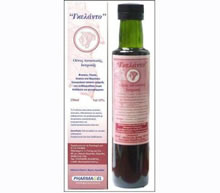
Λεξικό .. Omeprazole allergy
Omeprazole allergy
Omeprazole is an inhibitor of the parietal cell enzyme H+/K+ adenosine triphosphatase. Immediate-type hypersensitivity reactions, such as urticaria, angioedema, and hypotension, induced by omeprazole and other proton pump inhibitors are rare[1]. Although rare, anaphylactic reactions induced by proton pump inhibitors have been reported. The confirmation of the immediate-type mechanism of recurrent anaphylactic reactions to the repeated administration of omeprazole can be done using skin testing This procedure permits the safe administration of the drug after successful oral desensitization.
Lobera T et al et al (2009) presented a of cross-reactivity between different members of proton pump inhibitors. They studied 9 patients with adverse reactions to omeprazole. Clinical symptoms appeared immediately in 8 patients and after 4 hours in 1. Symptoms ranged from urticaria/angioedema in 7 cases to anaphylaxis in 2 cases. Skin prick tests and oral controlled challenge tests with omeprazole, lansoprazole, and pantoprazole were performed. Skin prick or intradermal tests with omeprazole were positive in 8 patients. Four were also positive to pantoprazole. Prick tests with lansoprazole were always negative. Lansoprazole was administered to all 9 patients, with good tolerance in 8. Only 3 patients were challenged with pantoprazole and developed widespread urticaria. The presented 9 patients were with immunoglobulin E-mediated allergy to omeprazole. In most of their cases, lansoprazole proved to be a good alternative treatment.
For the same reason Confino-Cohen R, Goldberg A. (2006) performed intradermal skin tests with omeprazole (0.04 and 0.4 mg/mL) prepared from the oral and intravenous commercial preparations and with pantoprazole (0.02 and 0.2 mg/mL) prepared from the oral commercial preparation. Skin tests were repeated after completion of the desensitization. Oral desensitization was applied at a starting dose of 0.001 mg of omeprazole, and a full dose of 16 mg was achieved after 5.6 hours (cumulative dose of 32.6 mg). Intradermal skin test results were positive to omeprazole and pantoprazole at all tested concentrations. After successful desensitization, omeprazole was administered in the full dose uneventfully. The wheal size of the intradermal skin tests performed after completion of the desensitization was significantly reduced. When indicated, this newly designed desensitization protocol may be used in patients with omeprazole-induced anaphylaxis.
References
1. Lobera T, Navarro B, Del Pozo MD, González I, Blasco A, Escudero R, Venturini M, Alarcón E. Nine cases of omeprazole allergy: cross-reactivity between proton pump inhibitors. J Investig Allergol Clin Immunol. 2009;19(1):57-60.
2. Confino-Cohen R, Goldberg A. Anaphylaxis to omeprazole: diagnosis and desensitization protocol. Ann Allergy Asthma Immunol. 2006 Jan;96(1):33-6.
Γκέλης Ν.Δ. - Λεξικό Αλλεργίας - Εκδόσεις ΒΕΛΛΕΡOΦΟΝΤΗΣ - Κόρινθος 2013
Gelis Ν.D. - Dictionary of Allergies - VELLEROFONTIS Publications - Corinth 2013




